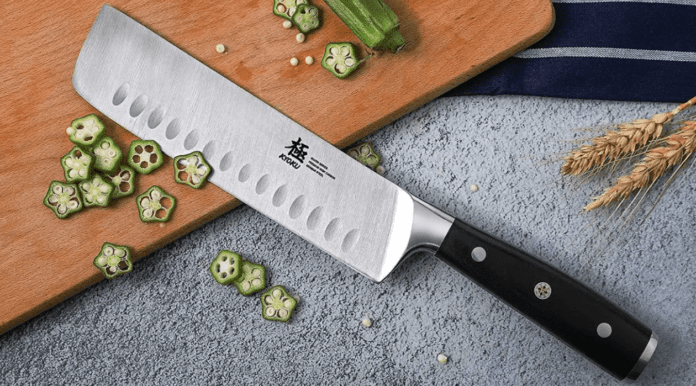There are numerous Japanese knife styles available, each designed for specific tasks. Different Japanese knives excel at different tasks. From all-purpose knives to specialized blades, understanding the nuances of each style can greatly enhance your culinary precision and efficiency.
Gyuto (Chef’s Knife)
The Gyuto is the Japanese equivalent of a Western chef knife. It typically ranges in size from 180mm to 300mm. It’s lighter and thinner than a European knife and is made out of harder steel. Gyuto literally translates to “cow sword”. The Gyuto features a long, slender blade with a slight curve, allowing for fluid rocking motions or precise push-pull cuts. It excels at slicing, dicing, and chopping, making it an ideal choice for home cooks seeking a multi-purpose knife. Blade length is a factor to consider when choosing a knife. An 8-inch knife is the most common and recommended for most people.
Santoku
The Santoku is a multi-purpose Japanese knife. Santoku means ‘knife of three virtues’. It features a shorter and wider blade compared to the Gyuto, with a straighter edge and a flat profile. The average Santoku measures up to 150mm-180mm, making it easy for beginners to wield. Consider the Kyoku Santoku knife for a versatile option. The Santoku is designed for versatility, excelling at tasks like slicing, dicing, and chopping vegetables, as well as cutting meat and fish. Its wider blade allows for easy food transfer from the cutting board to the pan or plate. The Santoku’s compact size and ergonomic design make it a favorite among home cooks for everyday use.
Nakiri
The Nakiri knife is designed for cutting greens. It features a straight, rectangular blade with a thin profile, allowing for efficient push cuts and downward slicing. Its thin and wide design allows for effortless slicing of vegetables, ensuring even cuts that steam perfectly while preserving their natural flavors and nutrients. The flat edge of the Nakiri makes it ideal for achieving clean, precise cuts on vegetables, herbs, and fruits. With its emphasis on vegetable-centric cuisine and precise cutting, the Nakiri is a must-have for home cooks who enjoy the art of vegetable preparation. Kyoku offers a variety of high-quality Japanese knives at competitive prices. If you’re looking for a Nakiri knife, you’re sure to find your ideal Japanese blade at Kyoku.
Sujihiki (Carving Knife)
The Sujihiki is a long and thin carving knife designed for boneless meats and vegetables to avoid tearing. Its long, narrow blade allows for extremely thin, precise cuts.
Other Knife Styles
Other styles include Honesuki, Ko-Bunka, and Funayuki. Honesuki is a boning knife. Consider the Kyoku boning knife for poultry and meat preparation. It was originally used with rabbits and poultry but can also be highly functional on fish and larger meat cuts.
Traditional vs. Western Style
Japanese knives are available in both single bevel and double bevel variations. Single bevel knives, known as “Yanagi” or “Usuba,” have a sharpened edge on one side only, making them ideal for precise cuts. Double bevel knives, such as the popular “Gyuto” and “Santoku,” have sharpened edges on both sides, offering versatility and ease of use. Japanese blades are forged from a harder, yet thinner, steel which results in greater durability. Single-bevel knives can be ground to a much finer angle than double-bevel ones, once again making for much sharper cuts and slices.
Knife Anatomy
Blade geometry is an important feature. Japanese knives are renowned for their thin and lightweight blades, allowing for precise and effortless cutting. The right length for you depends on your ergonomics. Generally, 200-210mm knives are considered average length.
Conclusion
There is a wide variety of Japanese knives available. Choosing the right knife for specific needs is very important. Japanese kitchen knives provide the precision, control, and sharpness needed to elevate your culinary creations. Whether you’re slicing delicate sashimi or dicing vegetables for a stir-fry, the right Japanese knife can make all the difference. Understanding the unique characteristics of each knife style empowers you to select the perfect tool for every culinary task, enhancing your overall cooking experience.





